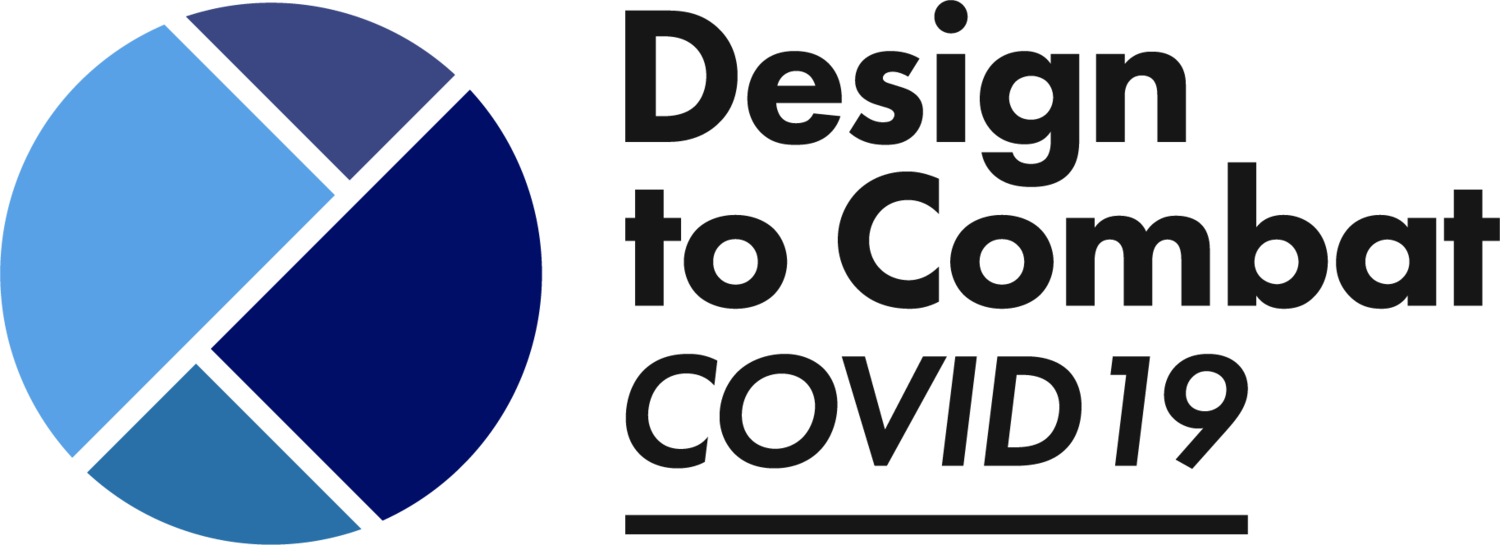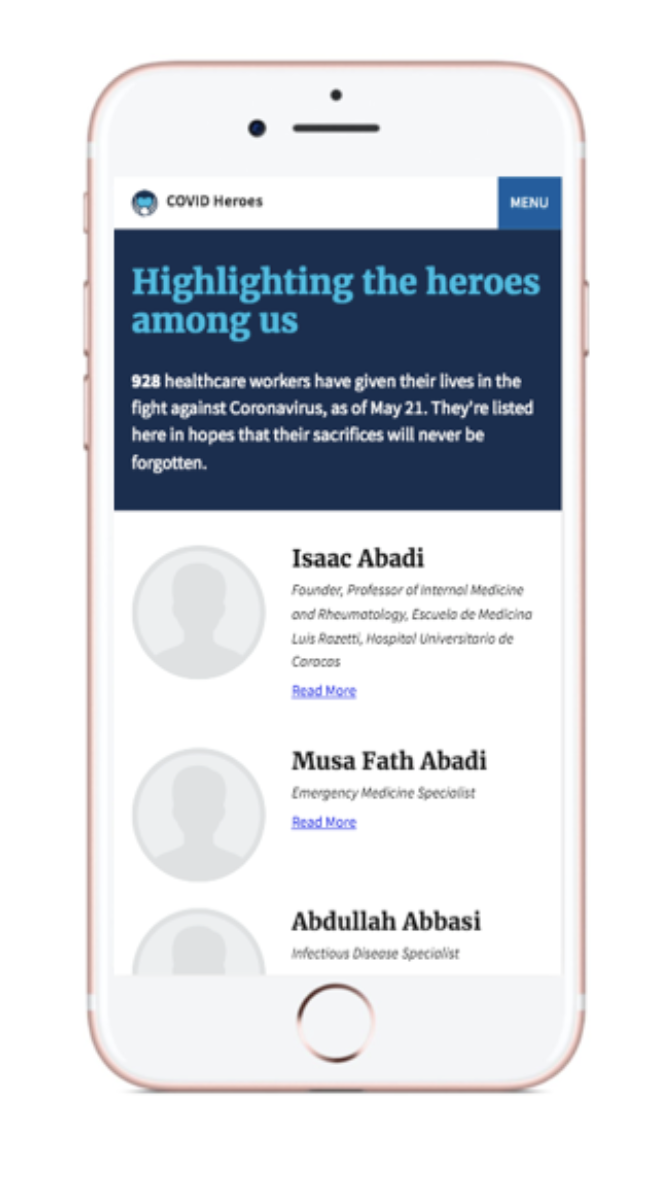Volunteer Impact spotlight: COVID Heroes
Throughout this crisis around the world there are nurses, doctors, and healthcare providers of all stripes that put their lives at risk to help save members of the public.
COVID Heroes honors their names.
Nov 11, 2020
From product design, logo design, UX testing, translations and more, our DCC19 team came together to bring COVID Heroes to life.
Tell us a bit about you. Where are you from, how did you get into design, and what kind of design do you focus on in your day-to-day work?
Nate: I was born in Missouri, grew up in New Hampshire, went to college in Virginia, started my career in New York City, and have now been living in LA for eight years. I found out there was a class at my high school where you could screen print your own t-shirts and stickers. To me, that sounded like a lot more fun than than Intro to World Literature or Child Growth & Development. However, my teacher, the late Leonard Abrahamson, wouldn't let us do anything fun until we completed all of the Photoshop and Illustrator tutorials, which I was grateful for years later. Fast forward many, many years... now I lead product design for a live entertainment company in Los Angeles.
Charles: I was born in Philadelphia and lived there until 2012. I guess you could say I had the life of a regular city kid growing up in West Philly. I come from a pretty large close knit family, many of whom lived within walking distance. What some people may consider a special occasion family get-together was pretty much how it was for us everyday. Not only my siblings, but aunts, uncles, cousins, grandparents, and even more extended family were also people that I interacted with on a daily basis.
At an early age, I was into electronics, computers, and video games, but I didn’t really know the path to working with any of those things as a career. After high school, I ended up going to Penn State for a few semesters with the intention of majoring in Computer Science. I left Penn State early and spent several several years in another industry before eventually transitioning into software development. In 2012, I completed my Bachelors Degree at Full Sail University and I moved to Los Angeles. Shortly after, I landed my first contract job building a website for a startup and have been a Software Engineer ever since.
Logo Design by Jason Liu
How did you hear about the DCC19 community and what was your expectation before joining?
Nate: I'm a part of a Slack group of designers and developers based in Los Angeles and I think someone mentioned the DCC19 group in there. Honestly, my expectations were pretty low because it was still early on in the COVID era for the U.S. and a lot of people were still grappling with what this all meant for their own work situation. So I didn't have high hopes of people donating their time to rally around my little project. But I was completely wrong and have been absolutely blown away by the response I get any time I put an ask out to the community.
Charles: I happen to work with Rachel Smith, the founder of DCC19. I saw Rachel posting about the community on her social channels and joined the Slack group to see how I could help.
“ It was at a point in time where it was becoming painfully obvious to me that we weren’t doing enough as a nation and things were about to get really bad.”
How did this project start?
Nate: On March 25, Maciej Ceglowski, sent a tweet suggesting a tribute site was needed for all the healthcare workers who lost their lives fighting the pandemic.
I took a quick look around the Internet and didn't see anything like what he was suggesting. It was at a point in time where it was becoming painfully obvious to me that we weren't doing enough as a nation and things were about to get real bad.
At the same time, I was also struggling with feeling a little powerless to personally do anything make things better other than being a responsible individual and shelter in place.
So, I decided to get to work on the memorial site and on March 27, I responded with a link to the very rough first version of the COVID Heroes site.
Tell us a bit about your project team. How did you find each other and how do you work together?
Nate: The project has grown tremendously since March, when it was just me. There are now at least 15 different people who have contributed in various ways. I lean on the admins of the DCC19 group a lot, Rachel Smith and Branden Byers. Whenever I feel like the project could benefit from more hands or needs skills that I don't possess, I tell them what I'm thinking. They usually have even better ideas and help me figure out the best way to put the ask out to the group.
The first major contribution included three designers: Chris Gray, Jason Liu, and Matias Rui. They collaborated to design the symbol for the project and give it an identity of its own. It was cool to see all the different ideas come together, through the push and pull of the creative process, and end up with something that I think everyone was happy with.
Finding and resizing and cropping the photos for each healthcare worker's profile was another overwhelming task. So Charles Reid, a developer in the group stepped up and created a tool that would take the images we found, crop them to the aspect ratio we needed, and in such a way that the main person in the image was centered. While Charles was building and fine-tuning that tool, Jolene Esposito did some brute force resizing and cropping of a big batch of images that had already been collected.
Usability Test Plan Dashboard by Chante De Freitas
Later on, after China had their national day of mourning we were able to track down a copy of some of the literature they'd put out which included the names of doctors that had never been mentioned in media reports. But it was all in Chinese, so Kaylee Liu and Melinda Chen spent hours translating the names and personal info of these folks. They carefully labeled all of their photos so we could easily include them on the site.
Additional designers are help us redesign several of the core pages on the site, as well as designing some new features to make it easier for visitors to navigate the site. We're also in the process of improving how profiles are added to the site so it can be an even more collaborative effort.
“Kaylee Liu and Melinda Chen spent hours translating the names and personal info of these folks (from Chinese to English). They carefully labeled all of their photos so we could easily include them on the site.”
Charles, Tell us about the custom cropping tool you developed.
Charles: Nate was looking for someone to help automate the image cropping process so that we didn’t have manually crop every COVID Hero image on the site. We needed the images cropped around the face proportionately, like a portrait. I wasn’t really sure how to do it at first, but I thought it would be a fun learning experience to figure out how.
I assumed there would be some open source libraries for facial recognition that did most of the heavy lifting, so I went in with the goal of creating something that I or another somewhat technical person could run via the command line that would take a folder full of images and spit out new, cropped versions.
I worked on it over a few evenings and tweaked the configuration a few times to get better face crops depending on the folder of images I was working with. The beauty of the tool is that once Nate sends me over a bunch of images, they can be cropped in seconds and if the crops don’t look great, I can quickly reconfigure and run it again. In the worst case scenario, we can still manually crop a few of them while most are taken care of automatically by this tool.
“There is an emotional weight to viewing many many images of healthcare workers who made the ultimate sacrifice in service of others.. We need to value the people we care about and give them their proverbial flowers while they’re still with us.”
What were the most gratifying and frightening moments along the journey?
Nate: The most gratifying part of this process was the response from the community. It's been overwhelming at times because there are so many people jumping at the chance to help make this little thing you created bigger and better than you thought it could be.
Logo Design by Jason Liu
The most frightening part is just how difficult it is to keep up with the site because of how many people are dying from the virus. When we started, it was easy to add 8 or 10 profiles every other night. But then the pandemic got worse and worse and it's become impossible to keep the site up-to-date on a day-to-day, or even week-to-week basis. We're almost 8 months from the first diagnosed case in the U.S. and healthcare workers around the world are still in grave danger on a daily basis.
Moreover, they are more than just profiles on a website. These are mothers and fathers, sons and daughters, sisters, brothers. Many of them came out of retirement to serve their communities. I wish we had done more to protect them while they were alive. But the very least we can do is remember these heroes and the sacrifices they made.
Charles: There is an emotional weight to viewing many many images of healthcare workers who made the ultimate sacrifice in service of others. I think the gravity of that is something I constantly faced while helping with this project. This just reinforced the idea that we need to value the people we care about and give them their proverbial flowers while they’re still with us.
“The very least we can do is remember these heroes and the sacrifices they made.”
Nate is a DCC19 volunteer and lead product design for a live entertainment company in Los Angeles.
Charles is a DCC19 volunteer and lead engineer for a fashion retail company in Los Angeles








